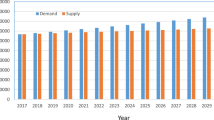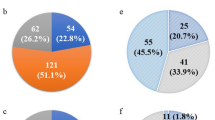Abstract
Background
Between 2003 and 2004, when the new postgraduate medical education program was introduced in Japan, the number of university residents decreased from 5,923 to 3,264 (−31%), whereas the number of non-university residents increased from 2,243 to 4,110 (+45%).
Objective
To identify potential reasons for the shift of residents from university to non-university hospitals.
Design
Cross-sectional mailed survey.
Participants
The subjects were 1,794 2nd-year residents at 91 university hospitals and 2,010 2nd-year residents at 659 non-university hospitals.
Measurements
Data on hospital demographics, resident demographics, and resident satisfaction with training were collected in 2006 and were compared between university and non-university hospitals.
Results
Compared to non-university hospitals, university hospitals were more likely to have >700 beds (55% vs. 10%, p<0.001) and to have more teaching resources and free access to international medical journals (84% vs. 62%, p<0.001). Nevertheless, one-half (47%) of the university residents reported that they were not satisfied with the residency system and clinical skills training and attributed their dissatisfaction to “daily chores,” “low salary,” and “poor clinical opportunities.” Logistic regression analyses indicated that the proportions of residents who were satisfied with income (OR: 0.32, 95% CI: 0.26–0.40) and the residency system (OR: 0.52, 95% CI: 0.40–0.68) and clinical skills training (OR: 0.77, 95% CI: 0.60–0.99) were significantly lower for university residents than for non-university residents.
Conclusions
Hospital size and teaching resources do not overcome the other characteristics of university hospitals that lead to residents’ dissatisfaction.
Similar content being viewed by others
References
Inoue K, Matsumoto M. Japan’s new postgraduate medical training system. Clin Teach. 2004;1:38–40.
Ministry of Health, Labour and Welfare. Transition of postgraduate training system [Ishikenshuuseidonohenkan]. Available at: http://www.mhlw.go.jp/topics/bukyoku/isei/rinsyo/index.html. Accessed April 15, 2008.
Teo A. The current state of medical education in Japan: a system under reform. Med Educ. 2007;41:302–8.
Yamaoka K, Kobayashi Y, Yano E. Length of in-patient stay in teaching hospitals in Japan. Med Educ. 1993;27:280–5.
Fukui T, Nishizaki O, Yano E. Evaluation of clinical care for so-called adult disease. To achieve appropriate care. In reports of the studies funded by the health foundation of Daiwa Security Corporation. Tokyo: Health Foundation of Daiwa Security Corporation; 1989:63–71.
Niino N, Yano E, Yamakado M, Maeshiro M, Takaku H. Time study on the activity of residents. Jpn J Public Health. 1989;36:484–8.
Yano E, Yamaoka K, Sugita S, et al. Comparing postgraduate medical education at university and non-university hospitals in Japan. Acad Med. 1992;67:54–8.
Fukui T. Evaluation study of the new postgraduate medical education system. Tokyo: St. Luke’s Hospital: 2006; Technical Report No. Iryo-015.
Association of Japanese Medical Colleges. Emergency Statement. Assoc Jpn Med Coll. 2006;48:23–5. (Sep).
Levine RB, Hebert RS, Wright SM. Resident research and scholarly activity in internal medicine residency training programs. J Gen Intern Med. 2005;20:155–9.
Ministry of Health, Labour, and Welfare. Survey of physicians, dentists, and pharmacists [Ishi shikaisih yakuzaishi chosa]. Tokyo: Kosei Tokei Kyokai; 2002.
Asano N, Kobayashi Y, Kano K. Issues of intervention aimed at preventing prospective surplus of physicians in Japan. Med Educ. 2001;35:488–94.
National Personnel Authority. 2006 Report of salary [Jinjiinkankoku to kyuuyo]. Available at: http://www.jinji.go.jp/kyuuyo/f_kyuuyo.htm. Accessed September 20, 2006.
Straus SE, Straus C, Tzanetos K. Career choice in academic medicine: systematic review. J Gen Intern Med. 2006;21:1222–9.
Kohlwes RJ, Shunk RL, Avins A, Garber J, Bent S, Shlipak MG. The PRIME curriculum. Clinical research training during residency. J Gen Intern Med. 2006;21:506–9.
Acknowledgments
This study was supported in part by grant H17-Iryo-015 from the Ministry of Health, Labor, and Welfare of Japan.
Conflict of Interest
None disclosed.
Author information
Authors and Affiliations
Corresponding author
Additional information
This study was supported in part by grant H17-Iryo-015 from the Ministry of Health, Labor, and Welfare of Japan.
Rights and permissions
About this article
Cite this article
Nomura, K., Yano, E., Mizushima, S. et al. The Shift of Residents From University to Non-University Hospitals in Japan: A Survey Study. J GEN INTERN MED 23, 1105–1109 (2008). https://doi.org/10.1007/s11606-008-0644-7
Published:
Issue Date:
DOI: https://doi.org/10.1007/s11606-008-0644-7




